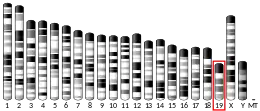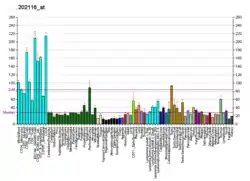DPF2
Zinc finger protein ubi-d4 is a protein that in humans is encoded by the DPF2 gene.[5][6]
The protein encoded by this gene is a member of the d4 domain family, characterized by a zinc finger-like structural motif. This protein functions as a transcription factor which is necessary for the apoptotic response following deprivation of survival factors. It likely serves a regulatory role in rapid hematopoietic cell growth and turnover. This gene is considered a candidate gene for multiple endocrine neoplasia type I, an inherited cancer syndrome involving multiple parathyroid, enteropancreatic, and pituitary tumors.[6]
References
- GRCh38: Ensembl release 89: ENSG00000133884 - Ensembl, May 2017
- GRCm38: Ensembl release 89: ENSMUSG00000024826 - Ensembl, May 2017
- "Human PubMed Reference:". National Center for Biotechnology Information, U.S. National Library of Medicine.
- "Mouse PubMed Reference:". National Center for Biotechnology Information, U.S. National Library of Medicine.
- Ninkina NN, Mertsalov IB, Kulikova DA, Alimova-Kost MV, Simonova OB, Korochkin LI, Kiselev SL, Buchman VL (Feb 2002). "Cerd4, third member of the d4 gene family: expression and organization of genomic locus". Mamm Genome. 12 (11): 862–6. doi:10.1007/s00335-001-3039-1. PMID 11845289. S2CID 2149578.
- "Entrez Gene: DPF2 D4, zinc and double PHD fingers family 2".
Further reading
- Gabig TG, Mantel PL, Rosli R, Crean CD (1994). "Requiem: a novel zinc finger gene essential for apoptosis in myeloid cells". J. Biol. Chem. 269 (47): 29515–9. doi:10.1016/S0021-9258(18)43910-5. PMID 7961935.
- Chestkov AV, Baka ID, Kost MV, et al. (1997). "The d4 gene family in the human genome". Genomics. 36 (1): 174–7. doi:10.1006/geno.1996.0440. PMID 8812431.
- Guru SC, Agarwal SK, Manickam P, et al. (1997). "A Transcript Map for the 2.8-Mb Region Containing the Multiple Endocrine Neoplasia Type 1 Locus". Genome Res. 7 (7): 725–35. doi:10.1101/gr.7.7.725. PMC 310681. PMID 9253601.
- Gabig TG, Crean CD, Klenk A, et al. (1998). "Expression and chromosomal localization of the Requiem gene". Mamm. Genome. 9 (8): 660–5. doi:10.1007/s003359900840. PMID 9680388. S2CID 22559464.
- Strausberg RL, Feingold EA, Grouse LH, et al. (2003). "Generation and initial analysis of more than 15,000 full-length human and mouse cDNA sequences". Proc. Natl. Acad. Sci. U.S.A. 99 (26): 16899–903. Bibcode:2002PNAS...9916899M. doi:10.1073/pnas.242603899. PMC 139241. PMID 12477932.
- Ota T, Suzuki Y, Nishikawa T, et al. (2004). "Complete sequencing and characterization of 21,243 full-length human cDNAs". Nat. Genet. 36 (1): 40–5. doi:10.1038/ng1285. PMID 14702039.
- Bouwmeester T, Bauch A, Ruffner H, et al. (2004). "A physical and functional map of the human TNF-alpha/NF-kappa B signal transduction pathway". Nat. Cell Biol. 6 (2): 97–105. doi:10.1038/ncb1086. PMID 14743216. S2CID 11683986.
- Beausoleil SA, Jedrychowski M, Schwartz D, et al. (2004). "Large-scale characterization of HeLa cell nuclear phosphoproteins". Proc. Natl. Acad. Sci. U.S.A. 101 (33): 12130–5. Bibcode:2004PNAS..10112130B. doi:10.1073/pnas.0404720101. PMC 514446. PMID 15302935.
- Gerhard DS, Wagner L, Feingold EA, et al. (2004). "The Status, Quality, and Expansion of the NIH Full-Length cDNA Project: The Mammalian Gene Collection (MGC)". Genome Res. 14 (10B): 2121–7. doi:10.1101/gr.2596504. PMC 528928. PMID 15489334.
- Olsen JV, Blagoev B, Gnad F, et al. (2006). "Global, in vivo, and site-specific phosphorylation dynamics in signaling networks". Cell. 127 (3): 635–48. doi:10.1016/j.cell.2006.09.026. PMID 17081983. S2CID 7827573.
External links
- DPF2+protein,+human at the U.S. National Library of Medicine Medical Subject Headings (MeSH)
This article incorporates text from the United States National Library of Medicine, which is in the public domain.
This article is issued from Wikipedia. The text is licensed under Creative Commons - Attribution - Sharealike. Additional terms may apply for the media files.




